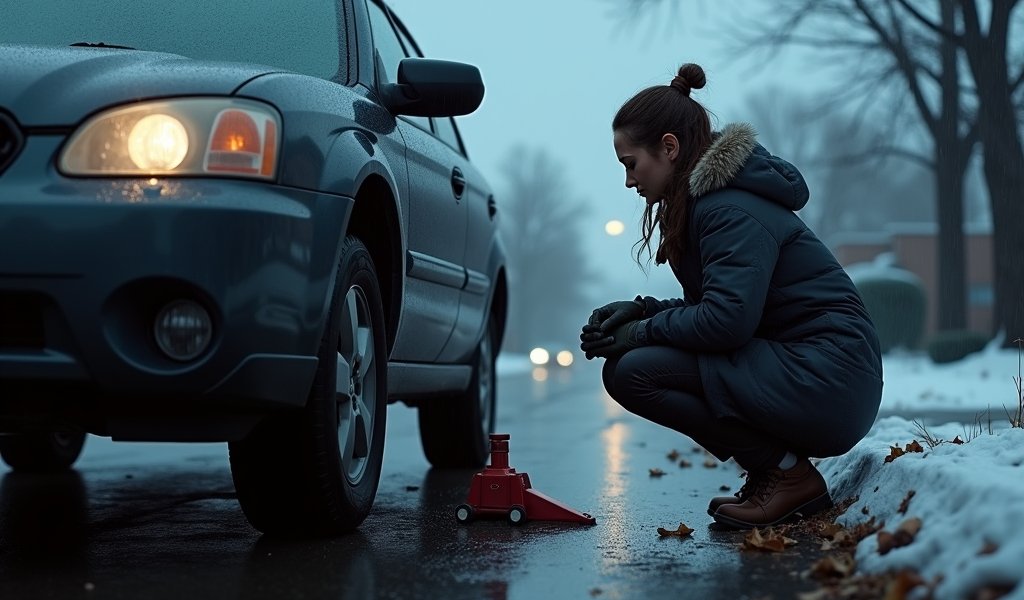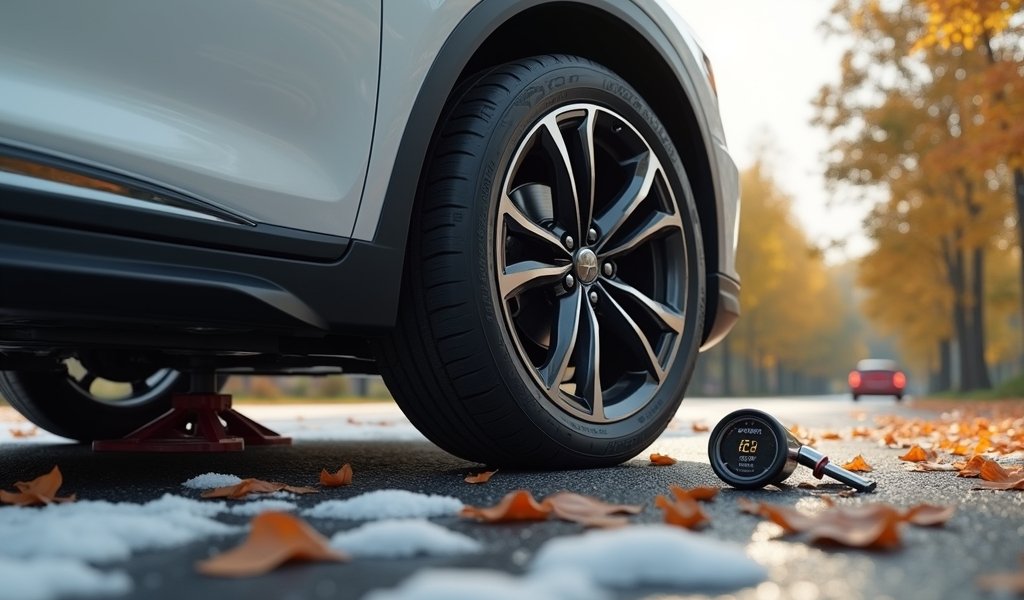Overview
This article presents seven essential seasonal tire care strategies including proper pressure monitoring, regular rotation, correct storage techniques, alignment checks, tread depth measurement, thorough cleaning, and winter tire preparation. Each practice helps extend tire life, improve vehicle safety, and optimize performance through changing weather conditions, with special emphasis on making adjustments based on temperature fluctuations throughout the year.
Table of Contents
- Understanding Seasonal Tire Care
- Importance of Tire Pressure Monitoring
- Hack 1: Seasonal Tire Rotation
- Hack 2: Proper Tire Storage Techniques
- Hack 3: Seasonal Alignment Checks
- Hack 4: Tire Tread Depth Monitoring
- Hack 5: Seasonal Tire Cleaning
- Hack 6: Tire Pressure Adjustments
- Hack 7: Winter Tire Preparations
- Conclusion
- Frequently Asked Questions
Understanding Seasonal Tire Care
As seasons change, so do the demands on your vehicle’s tires. When it comes to seasonal tire care tips, understanding how temperature fluctuations and weather conditions affect your tires is crucial for maintaining safety and extending their lifespan. From scorching summer heat to freezing winter conditions, each season brings unique challenges that can impact tire performance and safety.
In my 15 years as an ASE-certified mechanic, I’ve seen countless preventable tire issues that could have been avoided with proper seasonal maintenance. Think of your tires as the only point of contact between your vehicle and the road—they deserve attention throughout the year, not just when problems arise.
The good news? Effective tire care doesn’t require expensive equipment or professional expertise. With these seven proven seasonal tire care hacks, you’ll be able to maintain optimal tire performance year-round, potentially saving hundreds on premature replacements while ensuring safety for you and your passengers.
Importance of Tire Pressure Monitoring
If there’s one aspect of seasonal tire care that demands your attention, it’s tire pressure monitoring. For every 10°F change in temperature, your tire pressure typically changes by about 1 PSI. This means during seasonal transitions, your tires could be significantly under or overinflated without showing any visible signs.
Underinflated tires flex more while driving, generating excess heat that can lead to blowouts and premature wear. They also increase rolling resistance, which reduces fuel economy by up to 3% according to the U.S. Department of Energy. Conversely, overinflated tires provide less traction and wear unevenly across the center of the tread.
The solution is simple: check your tire pressure monthly and during significant weather changes. Your vehicle’s recommended tire pressure can be found in the driver’s door jamb or owner’s manual—not on the tire itself, which shows maximum pressure, not recommended pressure. Invest in a quality digital pressure gauge for accuracy, as the gas station varieties are often unreliable from heavy use.
During summer months, tire pressure in hot weather requires special attention as extreme heat can cause pressure increases that exceed safe limits. Meanwhile, winter brings rapid pressure drops that can affect handling precisely when you need optimal traction.

Hack 1: Seasonal Tire Rotation
Seasonal transitions offer the perfect opportunity to implement one of the most effective tire care practices: rotation. Most vehicles experience uneven tire wear patterns due to weight distribution and driving dynamics. Front-wheel drive vehicles typically wear front tires faster, while rear-wheel and all-wheel drive vehicles have their own distinct wear patterns.
By rotating your tires every 5,000-7,000 miles or with the changing seasons, you’ll ensure more even wear across all four tires. This simple practice can extend tire life by up to 20%, saving you considerable money over time. But the benefits extend beyond financial savings—evenly worn tires provide more consistent handling and traction in challenging conditions.
For most vehicles, the recommended rotation pattern is front-to-rear on the same side for directional tires, or a cross pattern for non-directional tires. However, always check your owner’s manual for vehicle-specific recommendations, as some high-performance vehicles require specialized rotation patterns.
Pro tip: Seasonal rotations also provide the perfect opportunity to inspect your tires for damage, unusual wear patterns, or embedded objects that could cause slow leaks. Make it a habit to perform a thorough visual inspection during each rotation.
Hack 2: Proper Tire Storage Techniques
If you’re among the growing number of drivers who switch between summer and winter tires, proper storage techniques are essential for preserving the integrity of your off-season set. Improper storage can lead to flat-spotting, sidewall cracking, and premature aging that compromises performance and safety.
First, thoroughly clean your tires before storage, removing road grime, brake dust, and debris. A gentle soap and water solution works perfectly—avoid tire dressings or petroleum-based cleaners that can degrade rubber compounds over time. Once cleaned, ensure tires are completely dry before storing to prevent mold and mildew formation.
Store your tires in a cool, dry location away from direct sunlight, heat sources, and electrical motors (which emit ozone that degrades rubber). The ideal storage temperature range is between 50-75°F. Avoid damp basements or outdoor sheds with extreme temperature fluctuations.
For optimal storage position:
- If tires are still mounted on rims, stack them horizontally or hang them from hooks that support the rim, not the tire
- For unmounted tires, store them standing upright, rotating their position monthly to prevent flat-spotting
- Consider using specialized tire totes or covers to protect against dust and contaminants
Remember, proper storage of best winter tires for cars during summer months ensures they’ll be ready to perform when winter conditions return. The same applies to your summer tires during the cold season.
Hack 3: Seasonal Alignment Checks
Wheel alignment might not seem directly related to tire care, but it’s one of the most influential factors affecting tire longevity and performance. Seasonal transitions, particularly in regions with harsh winters, often bring road conditions that can throw your alignment off—potholes, frost heaves, and curb strikes being the primary culprits.
An alignment check at the beginning of spring and fall provides an opportunity to identify and correct alignment issues before they cause significant tire damage. Even slight misalignment accelerates tire wear and can reduce fuel economy by creating additional rolling resistance.
Watch for these warning signs of alignment problems:
- Uneven or rapid tire wear, particularly on the edges
- Vehicle pulling to one side during straight driving
- Off-center steering wheel when driving straight
- Squealing tires, especially during moderate turns
While alignment requires professional equipment, many shops offer free alignment checks with other services. If you’ve recently hit a major pothole or notice any of the warning signs above, don’t wait for your seasonal check—address alignment issues promptly to prevent accelerated tire wear.
According to Hunter Engineering, a leading manufacturer of alignment equipment, proper wheel alignment can extend tire life by thousands of miles while improving handling and safety. Consider it preventive medicine for your tires and suspension components.

Hack 4: Tire Tread Depth Monitoring
Monitoring your tire tread depth is perhaps the most straightforward yet crucial aspect of seasonal tire care. Adequate tread depth ensures proper water evacuation, snow traction, and overall grip—all of which become especially important during seasonal weather changes.
The legal minimum tread depth in most states is 2/32″ (1.6mm), but this is truly the bare minimum for dry conditions. For rainy conditions, you’ll want at least 4/32″ (3.2mm) of tread to effectively channel water and prevent hydroplaning. And if you’re facing snow and ice, 6/32″ (4.8mm) should be your minimum threshold.
You can easily check your tread depth with a simple penny test: insert a penny into your tire’s tread groove with Lincoln’s head upside down. If you can see all of Lincoln’s head, your tread depth is less than 2/32″ and the tire needs replacement. For a more precise measurement, inexpensive tread depth gauges are available at any auto parts store.
Keep in mind that tires wear differently based on driving habits and alignment. Check multiple spots across each tire’s width and around its circumference. Uneven wear patterns can alert you to alignment, inflation, or suspension issues before they cause significant problems.
As we transition between seasons, take a moment to assess your tread depth. This five-minute check can prevent dangerous situations and help you plan for replacement before you’re caught in challenging weather with inadequate tires.
Hack 5: Seasonal Tire Cleaning
Tire cleaning might seem purely cosmetic, but it serves important functional purposes in a comprehensive seasonal tire care regimen. Road grime, brake dust, and environmental contaminants can degrade rubber compounds over time, leading to premature aging and reduced performance.
Seasonal deep cleaning removes these potentially harmful substances and gives you an opportunity to inspect your tires thoroughly for damage or irregular wear patterns. Start with a thorough rinse to remove loose debris, then use a dedicated tire cleaner and a stiff brush to remove stubborn contaminants.
Pay special attention to the sidewalls, where cracking often begins, and the area where the tire meets the rim, where slow leaks can develop. After cleaning, allow tires to dry completely before applying any dressings or protectants.
When selecting tire dressings, opt for water-based products rather than petroleum-based options, which can accelerate rubber deterioration. Quality silicone or water-based tire protectants help prevent UV damage and premature sidewall cracking without compromising rubber integrity.
Different seasons call for different approaches to tire protection. In summer, UV protection becomes paramount, while in winter, removing road salt and de-icing chemicals should be your priority. These harsh winter chemicals can accelerate corrosion of your wheels and potentially damage tire rubber if left in contact for extended periods.
Hack 6: Tire Pressure Adjustments
Beyond basic monitoring, strategic tire pressure adjustments for different seasons can optimize your vehicle’s performance and safety. As temperatures drop in fall and winter, tire pressure naturally decreases. Conversely, summer heat causes pressure to increase.
For winter driving, some experts suggest maintaining pressure at the higher end of the manufacturer’s recommended range (typically 2-3 PSI higher than the minimum) to compensate for the inevitable pressure drop in cold weather. This prevents the tire from running underinflated, which increases rolling resistance and wear.
In summer, check tire pressure during cooler times of day (early morning is ideal) for accurate readings. Pressure measured after driving or during peak heat will be artificially elevated. Remember that your goal is to maintain the manufacturer’s recommended cold inflation pressure regardless of ambient temperature.
For vehicles used in varied conditions, consider these seasonal adjustments:
- Slight pressure reduction (1-2 PSI below normal) for improved traction on loose or slippery surfaces
- Maintaining maximum recommended pressure for improved fuel economy during long highway trips
- Returning to standard pressure for general mixed driving
Always make these adjustments within the manufacturer’s recommended range—never exceed maximum pressure or go below minimum recommendations. According to research from Tire Rack, maintaining proper inflation pressure is the single most important maintenance step for maximizing tire life and performance.
Hack 7: Winter Tire Preparations
For drivers in regions with significant snowfall or extended periods below 45°F (7°C), winter tires represent the single most effective safety upgrade. Their specialized rubber compounds maintain flexibility in cold temperatures, and their unique tread designs provide superior traction on snow and ice.
The transition to winter tires should ideally occur before temperatures consistently fall below 45°F—not when the first snowfall arrives. This timing ensures you have appropriate traction during those first unexpected frost events that often catch drivers unprepared.
When installing winter tires, consider these preparations:
- Always install a complete set of four winter tires, not just two on the drive wheels
- Have wheels properly balanced during installation to prevent vibration
- Consider dedicated winter wheels (steel or inexpensive alloys) to prevent damage to your premium wheels from winter road salt
- Reset your TPMS system if equipped, accounting for the different pressure specifications of winter tires
For optimal winter performance, maintain winter tires at the pressure specified in your owner’s manual. Some manufacturers provide separate summer and winter pressure recommendations—check your documentation carefully.
Remember that winter tires wear more quickly on dry, warm pavement, so remove them promptly when spring temperatures consistently rise above 45°F. Their softer compounds aren’t designed for warm weather performance and will wear prematurely if used year-round.
Conclusion
Implementing these seven seasonal tire care tips doesn’t require extensive mechanical knowledge or expensive tools—just attention to detail and consistency. By incorporating these practices into your regular maintenance routine, you’ll significantly extend your tires’ useful life while enhancing safety and performance through all seasons.
Remember that seasonal tire care represents one of the highest-value maintenance activities you can perform. The modest time investment required for monitoring pressure, rotating tires, and performing visual inspections pays dividends in extended tire life, improved fuel economy, and enhanced safety during critical driving situations.
As the seasons change, take a few minutes to assess your tires’ condition and make necessary adjustments. Your tires are literally where the rubber meets the road—they deserve careful attention to ensure they perform their crucial safety role effectively, regardless of what Mother Nature throws your way.
Frequently Asked Questions
How often should I check my tire pressure throughout the year?
Check tire pressure at least once monthly and whenever significant temperature changes occur. A 10°F temperature change affects pressure by approximately 1 PSI.
Can I mix winter and all-season tires on my vehicle?
No, always use four tires of the same type. Mixing tire types creates dangerous handling imbalances and compromises stability.
What’s the best way to store off-season tires?
Store clean, dry tires in a cool, dark location away from ozone sources and petroleum products. Stack mounted tires horizontally or store unmounted tires standing upright.
How do I know when my tires need replacement?
Replace tires when tread depth reaches 4/32″ for all-season tires or 6/32″ for winter tires. Also replace regardless of tread if tires are over 6 years old or show cracking, bulging, or irregular wear.
Do I need to adjust tire pressure differently for highway driving versus city driving?
Maintain the manufacturer’s recommended pressure for all driving conditions. Pressure adjustments for driving styles remain within the recommended range and never exceed maximum sidewall pressure.

